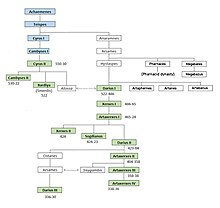Pharnaces (son of Arsames)

| Pharnacid dynasty (Satraps of Hellespontine Phrygia) | ||||||||||||||||||
|---|---|---|---|---|---|---|---|---|---|---|---|---|---|---|---|---|---|---|
|
||||||||||||||||||
Pharnaces Ι (Template:Lang-el; Elamite: Parnaka; c. 565–497 BCE) was a son of Arsames. He was a younger brother of Hystaspes, and therefore an uncle of Achaemenid Emperor Darius I, son of Hystaspes. He was the founder of the Pharnacid dynasty that ruled over Hellespontine Phrygia.[2][3]
Mayor of the Palace

According to the fortification tablets found at Persepolis, Pharnaces was the chief economic official to Darius I between 506 and 497 BCE.[2][4] He was a Mayor of the Palace, his statutory attribute being a short stick, probably made of a precious metal. He likely appears on some of the reliefs in Persepolis.[3]
Hellespontine Phrygia
Pharnaces became involved at some point with Hellespontine Phrygia in Asia Minor (modern northwest Turkey), since Aristotle of Stagira mentions that Pharnaces introduced mules in the region.[5][6]
Pharnaces had a son named Artabazus, who was appointed as satrap of Hellespontine Phrygia by Xerxes I circa 477 BCE. Artabazus and his heirs, known as the "Pharnacid dynasty" after Pharnaces, would rule the region into the 4th century BCE and until its take-over by Alexander the Great.[2][7][4]
References
- ^ Persepolis, Apadana, North Stairs, Central Relief - Livius.
- ^ a b c Briant, Pierre (2002). From Cyrus to Alexander: A History of the Persian Empire. Eisenbrauns. p. 339. ISBN 9781575061207.
- ^ a b Pharnaces (1) - Livius.
- ^ a b Stronk, Jan (2016). Semiramis' Legacy: The History of Persia According to Diodorus of Sicily. Edinburgh University Press. p. 206. ISBN 9781474414272.
- ^ Delphi Complete Works of Aristotle (Illustrated). Delphi Classics. 2013. p. 1408. ISBN 9781909496286.
- ^ Kitto, John (1852). The Popular Cyclopaedia of Biblical Literature: Condensed from the Larger Work. Gould and Lincoln. p. 108.
- ^ "The dynasty seems to have been founded by Pharnaces, the son of Arsames, Darius' uncle" in Achaemenid History. Nederlands Instituut voor het Nabije Oosten. 1988. p. 178. ISBN 9789062584031.
